Test: Manitou MLT 737 - 130 PS+ Elite
The Manitou MLT 737 – 130 PS+ Elite proves to be a great high-end machine that offers a lot to those intending to spend a serious amount of time in a telehandler
The pace at which machinery keeps developing never ceases to amaze me. Just when you think you have the ideal machine with everything you need, somewhere, someone is designing and incorporating something new that you didn’t even realise you needed.
 |
|
The Manitou has a lift capacity of 3.7 tonnes and a max lift height of 6.9m
|
Occasionally, this is little more than a gimmick, but other times, you wonder how you lived without it. Manitou has been building machinery since 1958 at its factory in France, refining and developing ideas.
The brand has been specifically building telehandlers since 1981, the timing of which seems to be the beginning of telehandler development for many brands.
 |
|
Rob Fuller from AB Equipment runs through the Manitou’s features
|
Since these basic early prototypes, the company has continued to improve its machines to the models we have today, one of which I got to check out on a recent trip to Canterbury.
Rob Fuller from AB Equipment, the New Zealand importer of Manitou, organised a newly released Manitou MLT 737 – 130 PS+ Elite model for me to test out in a working situation.
Engine
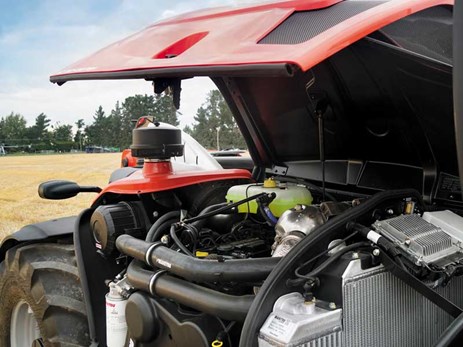 |
|
Powered by a 3.6-litre Duetz engine
|
Power for the Manitou comes from the reliable and commonly used four-cylinder 3.6-litre Deutz engine. This has been tuned to put out 129hp and meets Tier 4 emissions standards using AdBlue and a Diesel Particulate Filter.
This filter is self-cleaning with a burn cycle, alerting the driver via a light on the dash, while a switch in the cab allows it to be delayed (if working in a confined space perhaps) until a more convenient time.
The diesel and AdBlue tanks have a capacity of 120 litres and 10 litres respectively. Both are mounted high in the machine to prevent damage and are easy to access in clear distinct separate locations to prevent errors.
The engine sits east to west across the engine bay, which keeps the machine compact and stable but does mean access can be little tight for servicing. Thankfully, the dipstick is easy to get to.
Engine oil service intervals sit at 500 hours, with the hydraulic oil pushed out to a lengthy 2000 hours. As standard, a reversible fan is fitted to the radiator and a switch in the cab gives the operator the choice of on/off or auto.
When in auto mode, the fan is automatically reversed every three minutes for 15 seconds to clear the radiators out. This is a great system to keep the running temperature of the machine down in dusty environments without the operator having to worry about it.
Drive train
.jpg) |
|
The Easy Step Cab allows safer access with a full step to place feet onto when entering and exiting
|
The Powershift plus transmission is coupled to the engine with a torque converter in order to maintain smooth operating power at all times. With six forward gears giving a top speed of 40km/hr and three in reverse, gears can be changed manually with plus and minus buttons on the joystick, or the Manitou can be run in auto where the gears are changed up and down automatically as required.
In practice, the transmission works well and having the option of manual gives great control at slower speeds. When in auto, it changes seamlessly without the need to think about what gear you need to be in. Although there is a little lag between gears when changing, it’s similar to most other powershift transmissions.
Dana axles with a fixed front axle help maintain stability, and the oscillating rear axle creates maximum grip. Full-time four-wheel drive and a limited slip differential will also help you out of any sticky situations, with the enclosed hydraulic wet brakes providing trouble-free stopping power.
Tie rods are kept up above the axles out of harm’s way, and the entire unit sits on 460/70 R24 tyres to improve the ground clearance. Tough but flexible mudguards all round help keep the mud off the machine.
Unlike most other telehandlers, Manitou offers a choice of four steering modes: two or four-wheel steering and crab or Manicrab, which is essentially crab steering but with the rear wheels locked at an angle so it will ‘dog walk’ and can be steered with the front wheels.
This is particularly ideal for clearing out against a wall with a bucket, without risking damage to the machine. Steering modes are selected with buttons in the cab and when changing modes, a display shows when the wheels are in the aligned position.
Boom
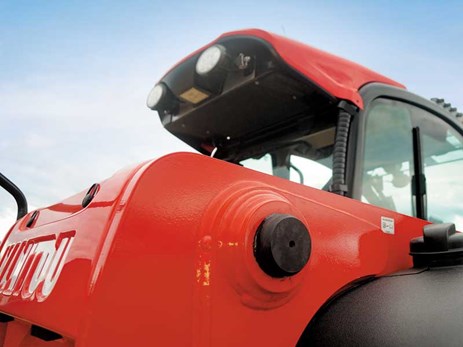 |
|
Some seriously heavy-duty reinforcing around the main pin for the boom
|
The boom is constructed to handle some seriously heavy weight. Two U-shaped sections are welded together on the sides for added strength, with a heavy 50mm pin joining it to the chassis.
With multiple layers of extra reinforcing around the pivmirrorsot point, greasing the whole machine is made easy, thanks to remote grease banks in convenient locations. Making it as easy as possible for the operator hopefully means it will get done.
Active CRC boom suspension is built into the main ram to smooth the ride out for the operator. This can be manually turned on/off or set automatically to turn the boom suspension off when the machine is under 5km/hr, allowing more accurate and precise control.
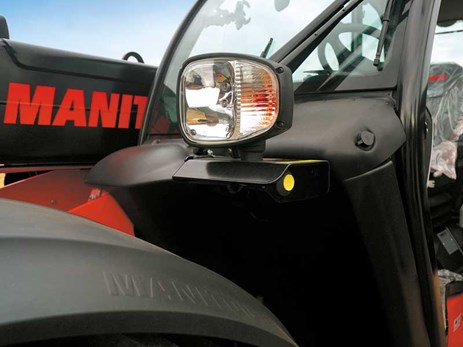 |
|
An easy-connect third service system with button to release hydraulic pressure
|
At the end of the boom, the Manitou headstock incorporates oversize hooks. These scoop up and retain the attachment, and the design allows for attachments to be picked up even when they are not sitting level on the ground. The tilt ram, as well as the hoses, are incorporated into the end of the boom, protecting them from damage behind the boom head.
An easy-connect third service system has a button on the left light bracket that releases the pressure in the hydraulic circuit. Not only is this convenient but it also makes attaching the hoses easy.
Attachments are easily secured to the headstock with hydraulic locking from the cab. A hydraulic load-sensing pump delivers 150 litres per minute from the 135-litre hydraulic oil tank, while a flow sharing distributor ensures oil is fed evenly where required for high-speed simultaneous movements.
Cab
 |
|
The well designed cab is comfortable for those spending long hours in the machine
|
Equipped with the top-spec Elite cab, the machine tested featured an impressive level of comfort. The deluxe Grammar air seat positions the operator well, reducing bumps and vibration, while extra cab soundproofing keeps noise levels down to just 73 decibels.
There are convenient storage compartments, a 12-volt lighter plug, and a convenient built-in USB plug for phone charging.
Instead of the standard two-piece stable door design most telehandlers feature, the Manitou has a sturdy single piece door with an electric window that slides into the door when lowered – a nice touch.
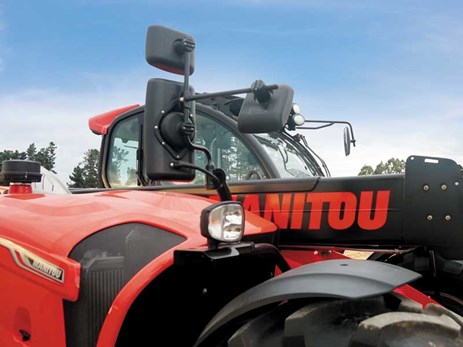 |
|
Excellent visibility, thanks to three mirrors on the right-hand side. The largest is electronically adjustable from the cab.
|
A recessed foot well gives a wide step inside the door, making access in and out extremely easy. And completing the useful line-up of features is a generous slide-out toolbox located under the cab next to the step.
The front windscreen is 90 degrees of curved glass, offering excellent visibility up to the maximum reach of the boom. It’s also fully FOPS and ROPS certified. A clever design feature sees the steel fins on the FOPS frame angled to line up with the operator’s view for minimal obstruction.
Windscreen wipers on the front, roof, and right-hand side windows ensure the operator’s visibility is clear in any conditions. Mirrors on the right side are a huge help and better yet, are electrically adjustable from the cab.
Controls
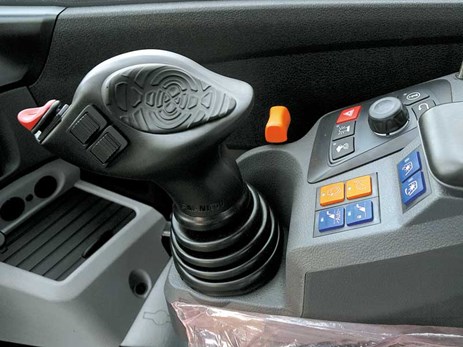 |
|
Once you’ve got used to the uniquely shaped Manitou JSM controller, the commonly used controls are at your fingertips
|
Key to control of the Manitou is the Joystick, Switch and Move (JSM) controller. Mounted on the floating right-side armrest, this is a unique joystick that your palm sits on top of.
Movement front to back and side to side gives control over the boom and headstock movement.
Two roller switches on the side give thumb control over the boom telescope and the third service. On top, a red toggle switch, controlled with your main finger, selects forward, reverse, and neutral. Plus and minus buttons (controlled with your index finger) are used to change gears up and down.
 |
|
The headstock has the tilt ram tucked inside the boom head, using oversized hooks to hold the attachment
|
While this set-up is quite different and does take some getting used to, it does put all the important controls at your fingertips.
The one thing missing for me is a left-hand reverser, but that’s because it’s hard to break the habits of a lifetime driving tractors and agricultural spec’d machines. I ended up turning on the indicators by mistake on several occasions just because I’m so used to that left-hand reverse.
A hand throttle dial allows the engine RPM to be set. This can be used to maintain RPM when loading and works well as cruise control on the road as well. Buttons to control most other functions of the machine can be found on the well-laid-out dash, with clear symbols, colour-coding, and intuitive grouping making it easy to find what you’re looking for.
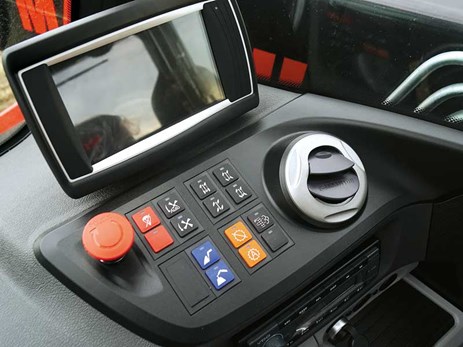 |
|
The screen and controls are clear and well laid out within easy reach
|
A clear, bright seven-inch colour screen set on the dash against the right-hand pillar shows all the vital machine stats, such as speed, rpm, temperature, current gear selected, direction of travel, and fuel and AdBlue levels.
Also incorporated into this same screen is a load monitor, which displays how close to the maximum load the machine is as at, as well as the boom angle and stats. Further menus can be scrolled through for additional information or adjustment of the way the machine operates.
Verdict
.jpg) |
|
The huge curved front window give a full 90 degree’s of vision so the operator can always see the attachment as it is raised
|
The Elite spec cab offers a high standard of comfort. Plus, it’s exceptionally quiet, thanks to the extra soundproofing. The recessed foot well and large grab handles make access very easy. Automatic shifting on the powershift transmission gives the operator one less thing to think about and the JSM controller puts the most commonly used functions at their fingertips.
Additional buttons on the dash and the clear monitor are well laid out and intuitive to use. It’s great to see electric mirrors and three windscreen wipers to ensure good driver visibility. The hydraulics are responsive and work well simultaneously while hydraulic locking and a pressure-release on the third service make hitching attachments easy.
All round, this is a great high-end machine that offers a lot to those intending to spend a serious amount of time in a telehandler.
See more telescopic handlers for sale in NZ
Manitou MLT 737 – 130 PS+ Elite specifications
| Engine | Duetz 3.6L, 4-cylinder, Tier 4 |
| Horsepower | 129hp |
| Transmission | 6-speed powershift with full auto |
| Max speed | 40km/hr |
| Hydraulic pump | Load sensing 150L/min |
| Weight | 7700kg |
| Lifting capacity | 3.7 tonne |
| Max lifting height | 6.9m |
| Max reach | 3.9m |
| Cab | FOPS/ROPS protection |
Pluses
- Responsive four-cylinder
- Tier 4 engine
- Reversing fan with auto cleaning cycle
- Six-speed powershift transmission with auto shifting
- Four steering modes
- Active automatic boom suspension
- Recessed footwell for easy cab access
- JSM controller puts commonly used buttons at your fingertips
Minuses
- No left-hand reverser
Watch the Manitou MLT 737 - 130 PS+ Elite
Keep up to date in the industry by signing up to Farm Trader's free newsletter or liking us on Facebook











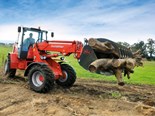



.jpg)

